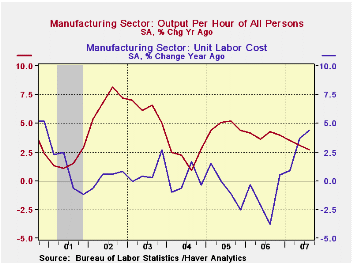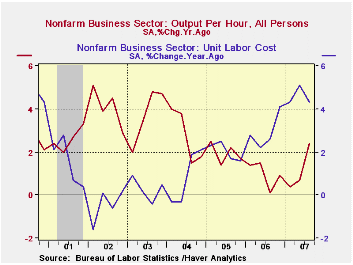 Global| Nov 07 2007
Global| Nov 07 2007Q3 Productivity Stronger, Unit Labor Costs Fell
by:Tom Moeller
|in:Economy in Brief
Summary
Nonfarm labor productivity surged 4.9% last quarter, more than double the rise during the second quarter. The increase was the quickest since the third quarter of 2003 and it lifted the y/y gain in productivity to its highest since [...]

Nonfarm labor productivity surged 4.9% last quarter, more than double the rise during the second quarter. The increase was the quickest since the third quarter of 2003 and it lifted the y/y gain in productivity to its highest since early 2005. Consensus estimates had been for a 3.0% rise,
Responsible for the surge was just a modest increase in the gain in output to 4.3% from a 4.2% rise during 2Q. An outright decline in hours worked, at a 0.5% rate, provided most of the oomph. The decline followed 2.0% growth during 2Q and it was the largest quarterly drop in over four years.
Moving with the gain in productivity was a q/q acceleration in
compensation per hour last quarter growth to 4.7%.
The modest acceleration from 2Q was sufficient to jump the annual gain
in compensation to 6.7%, its fastest since 2000.
As a result of the productivity surge, unit labor costs posted the first decline in over a year. As a result of that decline the y/y increase moderated, but just a bit, to 4.3% from 5.1% in 2Q.
Productivity in the factory sector showed similar improvement with a 4.6% gain. It was about double the 2Q increase but like the nonfarm total, the rise came more from a decline in hours worked than from a quicker gain in output. Compensation growth in the factory sector actually cooled a bit to 2.3% q/q but that did not prevent the annual gain from accelerating to 7.2%, its fastest since late 2003. Unit labor costs in the factory sector dropped 2.2%, the first decline in a year, but the annual increase rose to 4.4%.
As Boomers Slow Down, So Might the Economy from the Federal Reserve Bank of St. Louis is available here.
This morning's testimony by Fed
Governor Frederic S. Mishkin on the Availability of Credit to Small Businesses can be found here| Non-farm Business Sector (SAAR) | Q3 '07 Prelim. | Q2 '07 | Y/Y | 2006 | 2005 | 2004 |
|---|---|---|---|---|---|---|
| Output per Hour | 4.9% | 2.2% | 2.4% | 1.0% | 1.9% | 2.7% |
| Compensation per Hour | 4.7% | 4.4% | 6.7% | 3.9% | 4.0% | 3.6% |
| Unit Labor Costs | -0.2% | 2.2% | 4.3% | 2.9% | 2.0% | 0.9% |
Tom Moeller
AuthorMore in Author Profile »Prior to joining Haver Analytics in 2000, Mr. Moeller worked as the Economist at Chancellor Capital Management from 1985 to 1999. There, he developed comprehensive economic forecasts and interpreted economic data for equity and fixed income portfolio managers. Also at Chancellor, Mr. Moeller worked as an equity analyst and was responsible for researching and rating companies in the economically sensitive automobile and housing industries for investment in Chancellor’s equity portfolio. Prior to joining Chancellor, Mr. Moeller was an Economist at Citibank from 1979 to 1984. He also analyzed pricing behavior in the metals industry for the Council on Wage and Price Stability in Washington, D.C. In 1999, Mr. Moeller received the award for most accurate forecast from the Forecasters' Club of New York. From 1990 to 1992 he was President of the New York Association for Business Economists. Mr. Moeller earned an M.B.A. in Finance from Fordham University, where he graduated in 1987. He holds a Bachelor of Arts in Economics from George Washington University.






